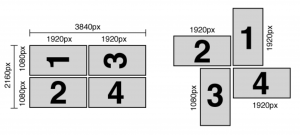If only all LED displays and all LCD displays were the same, this question would have a simple answer. That is not the case. Hence, we must take a deep dive into how an LCD/LED display works and what sets the two apart. Once we cover the basics, we’ll see specific contexts through which you can establish which suits your needs best. Let’s get started!
How does an LCD/LED display work
Both LCD and LED displays rely on liquid crystals to create an image. The main factor which sets them apart is the backlighting. LCDs rely on fluorescent backlights. Meanwhile, LED displays rely on light-emitting diodes to do the job. Because of this, LED displays are typically a lot brighter than LCD displays.
We say “typically” for a reason. Keep in mind that we’re focusing on the general definitions of these display types. There are different versions which further makes things complicated. For example, LED displays come in various backlight configurations. As a result, some look better than others. We won’t go too deep into the specifics of backlighting in this article and instead keep it simple! If you’re interested in the details, though, check out this article over at tomsguide.com.
Brightness and nits
A nit is a measurement unit for brightness. The higher the nit count, the greater the brightness of the display. As mentioned, because of the way they function, LED displays are usually brighter than LCD displays. An irrelevant measure for consumer purchases, brightness is very important for displays placed around a lot of sunlight. This is the case for all displays in the storefront or in the street. Whether you opt for a LED or LCD display, it’s good to know the number of nits you’re looking for. Here’s a quick rundown to give you an idea of what to look for!
Consumer-grade displays usually have up to 300 nits. Commercial-grade displays typically range from 400-700 nits. But displays with over 5,000 nits are also manufactured. These are the best choices for displays which are in direct competition with sunlight. They must be bright enough, otherwise the content won’t be visible. An LED display is more likely to meet the criteria for this level of brightness. Still, given the versatility of products on the market, don’t be surprised if you run into LCDs with a high nit count. To keep up with demand, they are also manufactured.
Image quality
LED displays are usually described as superior in terms of image quality. This refers to specific LED types, such as the Full Array LED TVs, where the LEDs are numerous and spread throughout the display. These types of LED TVs produce high quality visuals and, yes, are quite pricey. The main question is if for your use case you really need to invest in these expensive units.
Consider where and how you’ll be using your new displays. You might not need a 4K Full Array LED TV if it’s showing stills like a simple menu, an announcement, or a product description. The high resolution might not even be noticeable if there are no complex visuals. On the other hand, putting a large LED video wall featuring a waterfall in a hotel lobby will produce a stunning visual you simply can’t reproduce with cheap displays. It all boils down to the impact it will make on the viewer and what they will notice.
Video walls
Video walls are composed of multiple displays which work together to produce one massive display. Even if you’re not currently looking for displays to build a video wall with, it might be worth keeping video walls in mind as a possibility in the future. Maybe you’ll come up with new campaigns which will need a video wall, or you’ll simply want to use these displays once they’re replaced with newer ones one day. You never know!
Considering everything we’ve noted above, you likely already established that an LCD video wall will be cheaper than the LED variant. Correct! Consider these additional factors. LCD displays are broken up by a bezel, which is the separator from the display and its edge. So if you stack them, the bezel will be visible, no matter how thin. Meanwhile, LED displays may come with very thin or no bezel at all. Lastly, don’t forget that LEDs are brighter and can operate longer.
Which is better then?
The answer is clear! It depends on what you need them for.
In terms of image quality, brightness, and durability, LED displays are superior to LCD displays. This answer is enough if we entirely ignore the factor of price. LED displays look better than LCDs most of the time, but they cost more.
The challenge for you is to estimate where you truly need a more expensive LED display, and where a really good LCD will do the job while saving you money. For an indoor display which will run during work hours to show your latest offers, a regular LCD display will do the trick. Meanwhile, if you need a storefront display which will compete with direct sunlight on a daily basis and work non-stop, LED is your answer.
Whichever you choose, you can safely rely on quality digital signage software to manage your content and schedule it appropriately, both in the storefront or on the product floor. Speaking of indoor vs outdoor displays, the differences are greater than just the hardware. In fact, these differences may even affect the hardware you choose, so be sure to check them out!
Cover image by Jorge Soto Farias.









